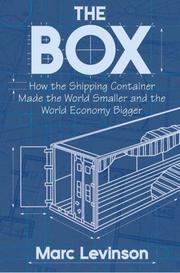| Listing 1 - 2 of 2 |
Sort by
|

ISBN: 0691123241 9780691123240 9780691136400 0691136408 Year: 2006 Publisher: Princeton, N.J. : Princeton University Press,
Abstract | Keywords | Export | Availability | Bookmark
 Loading...
Loading...Choose an application
- Reference Manager
- EndNote
- RefWorks (Direct export to RefWorks)
In April 1956, a refitted oil tanker carried fifty-eight shipping containers from Newark to Houston. From that modest beginning, container shipping developed into a huge industry that made the boom in global trade possible. 'The Box' tells the dramatic story of the container's creation, the decade of struggle before it was widely adopted, and the sweeping economic consequences of the sharp fall in transportation costs that containerization brought about. Published on the fiftieth anniversary of the first container voyage, this is the first comprehensive history of the shipping container. It recounts how the drive and imagination of an iconoclastic entrepreneur, Malcom McLean, turned containerization from an impractical idea into a massive industry that slashed the cost of transporting goods around the world. But the container didn't just happen. Its adoption required huge sums of money, both from private investors and from ports that aspired to be on the leading edge of a new technology. It required years of high-stakes bargaining with two of the titans of organized labor, Harry Bridges and Teddy Gleason, as well as delicate negotiations on standards that made it possible for almost any container to travel on any truck or train or ship. Ultimately, it took McLean's success in supplying U.S. forces in Vietnam to persuade the world of the container's potential. Drawing on previously neglected sources, economist Marc Levinson shows how the container transformed economic geography, devastating traditional ports such as New York and London and fueling the growth of previously obscure ones, such as Oakland. By making shipping so cheap that industry could locate factories far from its customers, the container paved the way for Asia to become the world's workshop and brought consumers a previously unimaginable variety of low-cost products from around the globe.
AA / International- internationaal --- 385.320 --- economie, internationaal --- geschiedkundige beschrijvingen --- globalisering --- handel, internationaal --- standaardisatie --- vervoer, containers --- vervoer, goederen --- Vervoer over zee: algemeenheden. --- McLean, Malcom Purcell, 1912-2001 --- Containerization --- Geografie --- History. --- Economische geografie --- Transport. --- McLean, Malcolm Purcell, --- Combined transport --- Container transportation --- Intermodal transportation --- Containers --- Freight and freightage --- History --- Vervoer over zee: algemeenheden --- Conteneurisation --- Histoire --- Conteneurisation - Histoire --- Containerization - History --- McLean, Malcolm Purcell, - 1913-2001 --- transport de marchandises --- conteneur
Book
ISBN: 9782281192933 2281192938 Year: 2006 Publisher: Paris : "AMC"-le Moniteur,
Abstract | Keywords | Export | Availability | Bookmark
 Loading...
Loading...Choose an application
- Reference Manager
- EndNote
- RefWorks (Direct export to RefWorks)
Les espaces de bureaux sont familiers et trop souvent sans surprise. Pourtant, en un peu plus d'un siècle, ils ont considérablement évolué. Aujourd'hui, au-delà des impératifs économiques et de la rationalisation des mètres carrés, les technologies innovantes ainsi que les enjeux environnementaux ouvrent la voie à de nouveaux modes de travail et à une architecture toujours plus audacieuse. A travers 25 projets réalisés dans le monde, ce livre présente un panorama des tendances architecturales actuelles et explore la diversité des espaces de travail: bureaux en blanc, paysagers ou cloisonnés, tours, locaux industriels transformés, lieux atypiques. Le bâtiment tertiaire doit s'intégrer dans son contexte, urbain ou naturel; sa dimension symbolique sera la première carte de visite de .l'entreprise. Il doit répondre à des exigences de fonctionnalité et de flexibilité mais aussi de confort. Enfin, les modes de travail eux-mêmes évoluent. Le bureau doit-il bannir toute fantaisie? Des réalisations originales proposent un cadre convivial, inspiré d'autres lieux familiers - la rue, la maison ou la boutique. En effet, comment concevoir aujourd'hui des espaces tertiaires alors que la frontière même entre l'activité professionnelle et la vie en dehors tend à s'estomper? (4Ème de couverture)
Office buildings. --- Offices --- Office layout. --- Immeubles de bureaux --- Bureaux --- Design and construction --- Conception et construction --- Aménagement --- Espace du travail --- Immeuble de bureaux --- Bureau --- Construction sur pilotis --- Conteneur --- Immeuble-tour --- Druot, Frédéric --- Ferrier, Jacques --- Fuksas, Massimiliano --- Gastines, Jean De --- Soler, Francis --- Viguier, Jean-Paul --- Wilkinson, Clive --- Autriche --- Barcelone --- Californie --- Chine --- Italie --- Londres --- Los angeles --- Oslo --- Paris --- San francisco --- Stockholm --- Strasbourg --- Tokyo --- Aménagement --- Espace de travail --- Paris (France) --- Architecture sur pilotis --- Fuksas, Massimiliano, --- Soler, Francis, --- Fuksas, Massimiliano, 1944 --- -Gastines, Jean De --- Soler, Francis, 1949 --- -Viguier, Jean-Paul
| Listing 1 - 2 of 2 |
Sort by
|

 Search
Search Feedback
Feedback About UniCat
About UniCat  Help
Help News
News